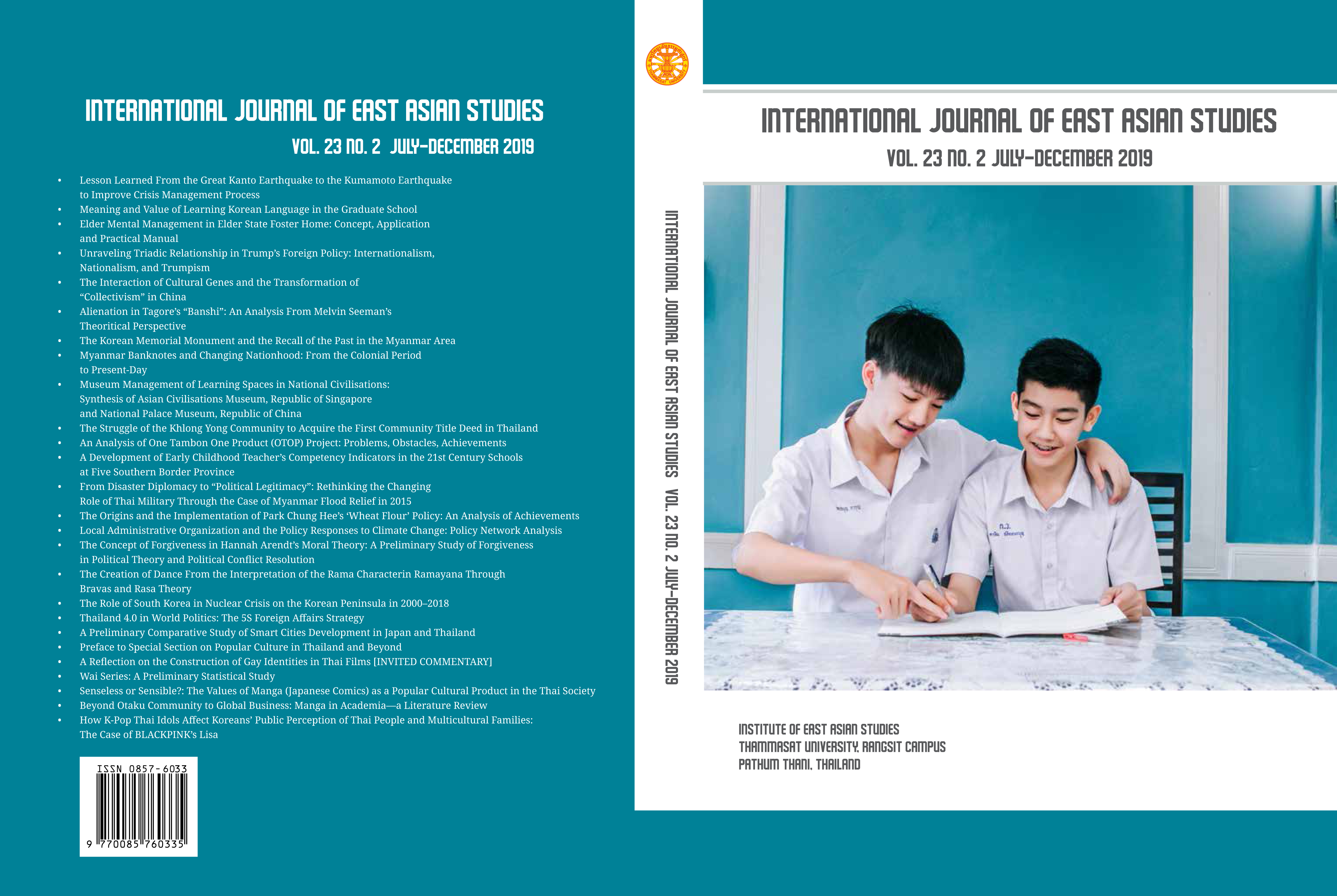ซีรีส์วาย: ข้อพิจารณาเบื้องต้นทางสถิติ
คำสำคัญ:
ซีรีส์วาย, ยาโออิ, บอยเลิฟ, บีแอล, ประเทศไทยบทคัดย่อ
ในช่วงไม่กี่ปีที่ผ่านมา ซีรีส์วายได้รับความนิยมอย่างยิ่งในหมู่วัยรุ่น ผู้ชื่นชอบสนใจสื่อบันเทิงไทย โดยซีรีส์วาย หมายถึง ละครชุดที่มีแก่นเรื่องนำเสนอความรักโรแมนติกและความเป็นเพื่อนคู่คิดของชายหนุ่มน่ารักและดูดีตามสมัยนิยม แม้ว่ากระแสนิยมซีรีส์วายจะขยายตัวอย่างรวดเร็ว แต่การเก็บข้อมูลเกี่ยวกับสื่อดังกล่าวอย่างเป็นระบบ และการวิเคราะห์เชิงประจักษ์ ยังคงมีอยู่อย่างจำกัด เช่นนี้แล้ว การศึกษานี้มีวัตถุประสงค์ 3 ประการ ได้แก่ (1) รายงานข้อมูลเชิงปริมาณเบื้องต้น (2) ตรวจสอบว่าการเข้าสู่การศึกษาปรากฏการณ์วายควรกระทำอย่างไร โดยใช้หลักฐานจากการวิเคราะห์เชิงปริมาณ (3) พิจารณาว่า การมีคู่วายเป็นตัวละครหลักของซีรีส์ มีผลต่อการจัดระดับความเหมาะสมของรายการกับกลุ่มผู้ชม หรือไม่
ข้อค้นพบของการศึกษา ชี้ให้เห็นว่า (1) ปรากฏการณ์วายสมควรเข้าสู่การศึกษาผ่านซีรีส์ ซึ่งมีคู่วายเป็นตัวละครหลัก (2) การมีคู่วายเป็นตัวละครหลักของโครงเรื่อง มีผลต่อการจัดระดับความเหมาะสมของรายการกับกลุ่มผู้ชม การศึกษายังเสนอข้อถกเถียงด้วยว่า ปัจจัยที่ส่งผลต่อการทะยานขึ้นอย่างมิอาจหยุดยั้งของซีรีส์วาย ได้แก่ (1) การตั้งมั่นของวัฒนธรรมสาววาย (2) การตื่นตะลึงทางแนวสื่อ ปี ค.ศ. 2007 และ (3) โอกาสทางธุรกิจ อนึ่ง การศึกษาสรุปด้วยการตั้งข้อสังเกตว่า เป็นไปได้หรือไม่ที่ "ความไร้กลิ่นทางวัฒนธรรม" เป็นหัวใจที่ทำให้ซีรีส์ได้รับกระแสตอบรับอย่างดียิ่งในหมู่วัยรุ่นเอเชียตะวันออก
Downloads
References
Abu-Bader, S. H. (2016). Using Statistical Methods in Social Science Research: With a Complete SPSS Guide (2nd ed.). Oxford and New York: Oxford University Press.
Bangkok Post. (2017, December 1). While TV viewing shifts to apps, cinema stays strong as ever. Bangkok Post.
Baudinette, T. (2019). Lovesick, The Series: adapting Japanese ‘Boys Love’ to Thailand and the creation of a new genre of queer media. South East Asia Research, 27(2), 115-132. doi:10.1080/0967828X.2019.1627762
Blair, M. M. (2010). 'She should just die in a ditch': Fan reactions to female characters in boys' love manga. In A. Levi, M. McHarry, & D. Pagliassotti (Eds.), Boys’ Love Manga: Essays on the Sexual Ambiguity and Cross-Cultural Fandom of the Genre (pp. 110-125). Jefferson, NC: McFarland & Company.
Bunyavejchewin, P. (2018, May 25-27). The Wai (Y[aoi]) Genre: Local BL Media in Thailand. Paper presented at the Mechademia Conference on Asian Popular Cultures, Kyoto.
Bunyavejchewin, P. (n.d.). The Queer If Limited Effects of Boys Love Manga Fandom in Thailand. In J. Welker (Ed.), Queer Transfigurations: Boys Love Media in Asia. (in preparation).
Farmer, B. (2011). Loves of Siam: Contemporary Thai Cinema and Vernacular Queerness. In P. A. Jackson (Ed.), Queer Bangkok: 21st Century Markets, Media, and Rights (pp. 81-98). Hong Kong: Hong Kong University Press.
Jackson, P. A. (1999). Tolerant but Unaccepting: The Myth of a Thai 'Gay Paradise'. In P. A. Jackson & N. M. Cook (Eds.), Genders & Sexualities in Modern Thailand (pp. 226–242). Chiang Mai: Silkworm Books.
Jackson, P. A. (2011). Capitalism, LGBT Activism, and Queer Autonomy in Thailand. In P. A. Jackson (Ed.), Queer Bangkok: 21st Century Markets, Media, and Rights (pp. 195-204): Hong Kong University Press.
Jung, S. (2009). The Shared Imagination of Bishōnen, Pan-East Asian Soft Masculinity: Reading DBSK, Youtube.com and Transcultural New Media Consumption. Intersections: Gender and Sexuality in Asia and the Pacific, (20). Retrieved from http://intersections.anu.edu.au/issue20/jung.htm
Kanokwan, M. (2019, October 24). LINE TV Doenna Khayai Than Phut Mok Lum mass Phrom Chap Aep Long Thiwi Rap Sen A Yai. Forbes Thailand. Retrieved from https://forbesthailand.com/news/it/line-tv-เดินหน้าขยายฐานผู้ชมก.html
Leesa-nguansuk, S. (2019, October 28). Line TV adding shopping feature for viewers in 2020. Bangkok Post. Retrieved from https://www.bangkokpost.com/business/1781179/line-tv-adding-shopping-feature-for-viewers-in-2020
Limkangvanmongkol, V., & Abidin, C. (2018). Microcelebrity Around the Globe: Approaches to Cultures of Internet Fame. In C. Abidin & M. L. Brown (Eds.), Microcelebrity Around the Globe: Approaches to Cultures of Internet Fame (pp. 95-106). Bingley: Emerald Publishing Limited.
Mallinson, K. (2015). Smartphone Revolution. IEEE Consumer Electronics Magazine, 4(2), 60-66. doi:10.1109/MCE.2015.2392954
Mani, D. (2016, August 15). App economy: Shift from desktop to mobile is the new market trend. The Economic Times. Retrieved from https://economictimes.indiatimes.com/blogs/et-commentary/app-economy-shift-from-desktop-to-mobile-is-the-new-market-trend/
Margalit, L. (2018, July 19). The Rise of the 'Mobile Mindset' and Its Impact on Customer Behavior. SmarterCX.com. Retrieved from https://smartercx.com/the-rise-of-the-mobile-mindset-and-its-impact-on-customer-behavior/
McLelland, M. J. (2000). The Love Between ‘Beautiful Boys' in Japanese Women's Comics. Journal of Gender Studies, 9(1), 13-25. doi:10.1080/095892300102425
Nagaike, K. (2015). Do Heterosexual Men Dream of Homosexual Men?: BL Fudanshi and Discourse on Male Feminization. In M. McLelland, K. Suganuma, J. Welker, & K. Nagaike (Eds.), Boys Love Manga and Beyond: History, Culture, and Community in Japan (pp. 189-209). Jackson, MS: University Press of Mississippi.
Nation TV. (2019, August 19). Poet Tua Si Ri Wai Isan TGIF THE SERIES. Nation Channel. Retrieved from https://www.nationtv.tv/main/content/378733454/
Pagliassotti, D. (2010). Better than romance?: Japanese BL manga and the subgenre of male/male romantic fiction. In A. Levi, M. McHarry, & D. Pagliassotti (Eds.), Boys’ Love Manga: Essays on the Sexual Ambiguity and Cross-Cultural Fandom of the Genre (pp. 59-83). Jefferson, NC: McFarland & Company.
Pagliassotti, D., Nagaike, K., & McHarry, M. (2013). Editorial: Boys’ Love manga special section. Journal of Graphic Novels and Comics, 4(1), 1-8. doi:10.1080/21504857.2013.793207
Peecharoen, P. (2014). Khwamchop Duai Kotmai Khong Nangsue Katun Yipun Praphet Chai Rak Chai Chak Mum Mong Niti Setthasat [Legitimacy of Yaoi Manga in Law and Economic Aspect]. (Master’s thesis). Thammasat University, Bangkok.
Pimsak, A., & Unthaya, S. (2017). SOTUS Phi Wak Tua Rai Kap Nai Pi Nueng: Kan Prakop Sang Atta Lak Phet Nok Krop Nai Nawaniyai Rak Wairun Naeo Wai [SOTUS The Evil Sophomore and the Freshman: Construction of Queer Identity in the Y Novel; Special issue]. Warasan Kan Borihan Pokkhrong [Governance Journal], 6, 174-193. Retrieved from https://so01.tci-thaijo.org/index.php/gjournal-ksu/article/view/98243
Prasannam, N. (2019). The Yaoi Phenomenon in Thailand and Fan/Industry Interaction. Plaridel: A Philippine Journal of Communication, Media, and Society, 16(2), 63-89. Retrieved from http://www.plarideljournal.org/article/the-yaoi-phenomenon-in-thailand-and-fan-industry-interaction/
Schodt, F. L. (1996). Dreamland Japan : Writings on Modern Manga. Berkeley: Stone Bridge Press.
Srisukho, D. (1987). Kan Thotsop Sommottithan Duai Khaisakhae. Warasan Withi Witthaya Kan Wichai [Journal of Research Methodology], 2(3), 38-51. Retrieved from https://portal.edu.chula.ac.th/pub/jrm/index.php/jrm/article/view/336
Ünaldi, S. (2011). Back in the Spotlight: The Cinematic Regime of Representation of Kathoeys and Gay Men in Thailand. In P. A. Jackson (Ed.), Queer Bangkok: 21st Century Markets, Media, and Rights (pp. 59-80). Hong Kong: Hong Kong University Press.
Watson, J., & Jirik, K. (2018, June 20). Boys' love: The unstoppable rise of same-sex soapies in Thailand. ABC News. Retrieved from https://www.abc.net.au/news/2018-06-16/boys-love-same-sex-dramas-in-thailand/9874766


